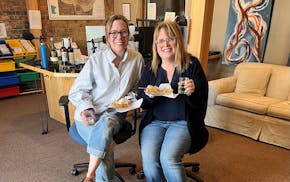Q: Do birds of one species "talk" to other bird species?
A: That's an excellent question and the answer falls into the "It depends" category. We hear birds singing loudly in the spring, but each species is communicating with others of their kind, to court a mate or establish a territory. A territory may include several different bird species, if they're not in competition for food and other resources, so a robin's "stay away" song won't discourage a cardinal, for example. Birds do listen if one species gives its alarm call when a predator is around: My backyard clears instantly when a chickadee gives its soft alarm note, for example, and blue jays can have the same effect on multiple bird species (even though the jays often are "crying wolf"). Birds know which songs and calls to filter out, and which to really pay attention to. Some birds chatter a lot when they're foraging through a woodland or a field, and this can attract other birds interested in the same diet. You see this with chatty chickadees attracting warblers, woodpeckers, brown creepers and other birds to form a brief foraging flock.
Hiding but not seeking?
Q: I sit outside at my condo and toss out peanuts (in the shell) for the blue jays. They hide them in the grass or go to a rooftop and return right away. I wonder if they ever come back later to retrieve them.
A: I like the sounds of your after-dinner entertainment, and the blue jays must enjoy it, too. They do remember where they've hidden their bounty, and return often to retrieve the nuts and peck open the shells for the prize inside. Blue jays can be very secretive, both in making sure they're not watched by other birds when they tuck a nut into a hiding place, and when they retrieve a peanut for a meal. They often return to re-hide a food item if they feel other jays (or humans) were watching the first time. And truth to tell, they don't re-find every single nut, and many an oak tree has grown from a forgotten blue jay acorn.
Hold the salt
Q: When you mention putting out peanuts for birds, I assume you mean unsalted ones? Where can I find these?
A: You are so right, salted nuts aren't good for birds and should be avoided. I find unsalted peanuts, both in the shell and without shells, at wild bird stores, and at some hardware stores and big box stores. They're a fun item to offer to your backyard birds: Blue jays love the peanuts in the shell, and many other birds, from chickadees to woodpeckers to sparrows, enjoy pecking at shelled peanuts in a mesh feeder.
Lifetime bond
Q: Do cardinals mate for life? I see a male and female together in my backyard, even now, when nesting season is over with.
A: Cardinals stay together throughout the year, and this makes it easier to start the breeding season each spring. In fall and winter, cardinals no longer feel the need to defend a territory, so you might see a flock of brilliant red males and subtle taupe-colored females brightening up the backyard or woodland.
Deterring sparrows
Q: We enjoy feeding birds but house sparrows are getting us down. They eat so much seed and keep the desirable birds away. I've spent hours on all the usual suggestions, including making the "halo" with wires and washers, and none of these work for very long. Do you have any suggestions?
A: Sorry to hear you're being bedeviled by these feeder pests. I do have a suggestion, although it's not a perfect solution: Switch to safflower seeds. House sparrows don't seem to enjoy safflower as much as they do sunflower seeds. After I made the switch, I saw a noticeable drop-off in sparrow visits to my feeders. Many other birds, including chickadees, cardinals and house finches, will eat safflower (and in the spring, the rose-breasted grosbeaks seem to seek out this seed). Sparrows will continue to visit for a while, swishing their beaks back and forth in the safflower seed, checking to see whether there's any good stuff underneath. In my experience, our winters are hard on non-native house sparrows, and their numbers decline as the season advances, if that's a consolation.
New name, same goals
Q: Why is the St. Paul Audubon Society changing its name?
A: The local organization's new name is Saint Paul Bird Alliance, aligning it with many other chapters (including Minneapolis') around the country that have dropped "Audubon" from their name. The St. Paul chapter board says that the Audubon name was creating barriers to pursuing a broader coalition of people and organizations to achieve its mission of protecting birds and their habitats. The national organization will still be known as the National Audubon Society, however.
Hands off birds' nests
Q: Now that the leaves are down, I see many abandoned birds' nests on my daily walks. I'd like to collect some to make a collage.
A: Bird nests are so beautifully made and they each tell a story about the breeding season, so I can understand how you feel. But it's best to leave them alone: Under the Migratory Bird Treaty Act, it's illegal to collect any part of a bird, from feathers to eggs to nests.
Don't toss nature's foods
Q: My neighbors try to outdo each other in their efforts to make their gardens neat and tidy each fall, by cutting everything down and tossing it in the compost pile or the trash. I don't think they approve of my habit of leaving all the plant stalks and seed heads standing, but I love to look out on a winter day and see the finches and sparrows feasting away on the seeds.
A: You are so right, many gardeners seem to think that the outside of their homes must be as tidy as the insides. It breaks my heart to see all the seed heads that end up in compost piles and yard waste sites, because this could be valuable food for birds and other small creatures in the winter. Gardeners: Please leave seed stalks standing until spring — your neighborhood birds will thank you.
St. Paul resident Val Cunningham, who volunteers with bird organizations and writes about nature for local, regional and national newspapers and magazines, can be reached at valwrites@comcast.net.

When West Seventh Pharmacy closes, St. Paul will lose a piece of history and personal care

John Cusack dishes on 'High Fidelity' at Minneapolis screening

For 'Legally Blonde' star, 'being underestimated is her secret superpower'

Restaurant openings and closings in the Twin Cities

